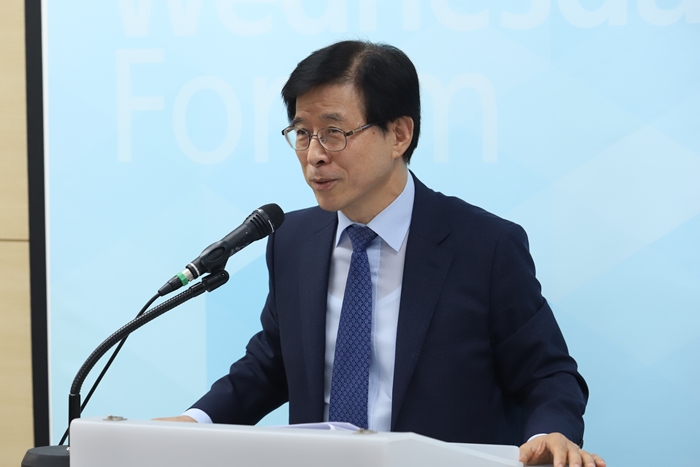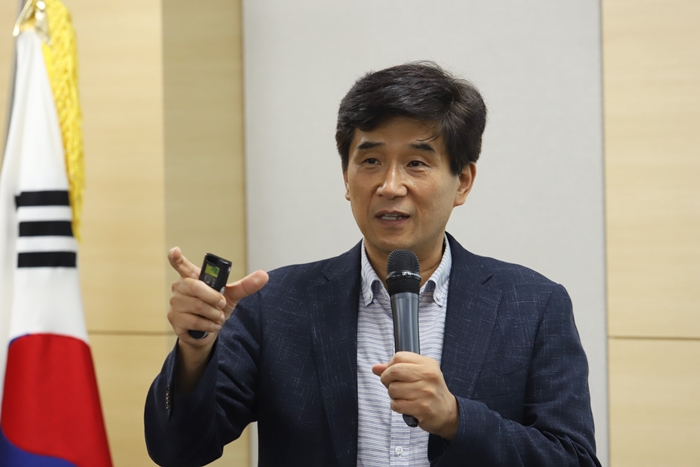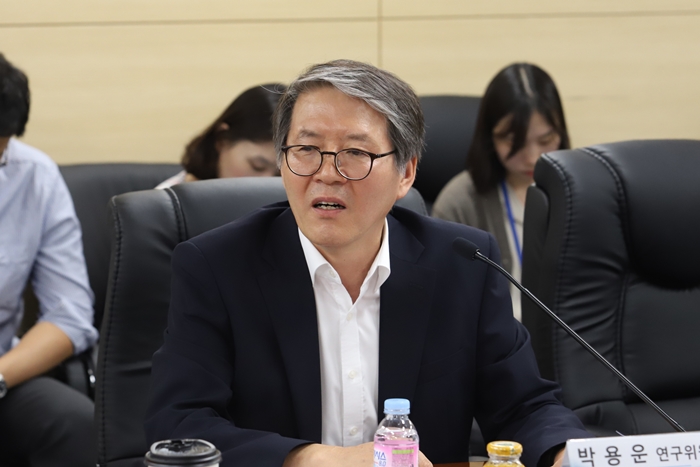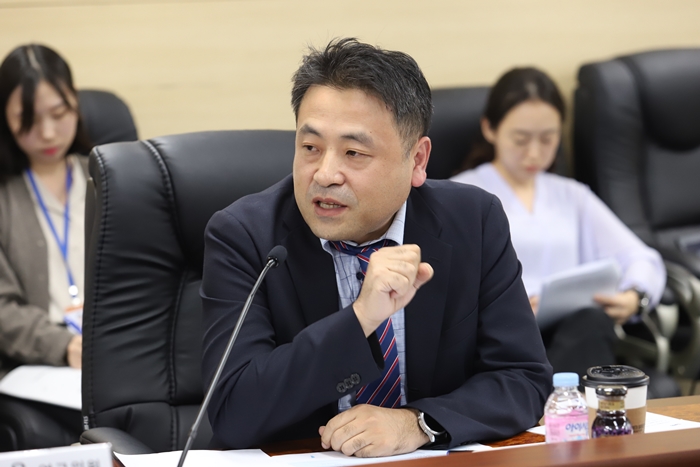News & Event


News & Event
News & Event
[The 110th Wednesday Forum] K-DARPA: Integration of Innovative DNA of DARPA and Open Convergence Research
- Writer Yeory Lim
- Date2019-09-11
- Hit1,034
File
-
Download
 20190911085842.jpg
(175.52KB / Download 213회)
20190911085842.jpg
(175.52KB / Download 213회)
KISTEP held the 110th Wednesday Forum with the theme of ‘K-DARPA: Integration of Innovative DNA of DARPA and Open Convergence Research’ on September 4th (Wed), 2019.
Strengthening national R&D for new challenges is required to respond radical global changes in science technology, politics, and environment, and to secure our own innovative technologies to lead the world. US Defense Advanced Research Projects Agency (DARPA) became an icon of national R&D innovation as it presents world-changing innovative technologies such as Global Positioning System (GPS), stealth technology, and voice recognition system. Taken these successful models, Europe and Japan are investing intensively in developing disruptive innovative technologies. Korea is also putting great efforts in innovating national R&D. This forum was prepared to share fearless adventurous research cases, and to seek policy options to promote the disruptive DARPA project of Korea(K-DARPA) effectively.
Strengthening national R&D for new challenges is required to respond radical global changes in science technology, politics, and environment, and to secure our own innovative technologies to lead the world. US Defense Advanced Research Projects Agency (DARPA) became an icon of national R&D innovation as it presents world-changing innovative technologies such as Global Positioning System (GPS), stealth technology, and voice recognition system. Taken these successful models, Europe and Japan are investing intensively in developing disruptive innovative technologies. Korea is also putting great efforts in innovating national R&D. This forum was prepared to share fearless adventurous research cases, and to seek policy options to promote the disruptive DARPA project of Korea(K-DARPA) effectively.

▲ Sang-seon Kim (President, KISTEP)
The forum began with the opening address by Sang-seon Kim (President, KISTEP) and followed by the presentation of Kwang-Ryeol Lee (Director, Technology Policy Research Institute, Korea Institute of Science and Technology (KIST)). Panel discussion were led by Yong Woon Park (Senior Researcher, Agency for Defence Development) and Do Hyoung Lee (Director, Center for Future Growth Policy, KISTEP), and open floor discussion followed.

▲ Kwang-Ryeol Lee (Director, Technology Policy Research Institute, KIST)
Director Kwang-Ryeol Lee explained the problems in R&D of Korea first. He clarified the problems as ▲outdated R&D supporting system, ▲lack of innovation capability, and ▲loose performance diffusion system, and claimed that formal R&D innovation plans based on those problems have limitations. Then he explained the current status of science and technology in Korea and new direction to move forward using the term called ‘Advanced research.’ ‘Advanced researchers’ of advanced research discover new areas, leave from familiarity, and question about essential matters. But they so far existed as ‘plausible advanced researchers’ filling up frames that were already made by advanced researchers. Designing a new frame is what real advanced research should do, he added. In order for researchers to challenge advanced research, he suggested that it is required to have a system tolerating failures, a R&D atmosphere not pressed by time and conditions, and development of the 4th industrial R&D infrastructures.
Director Lee presented innovative ecosystem of DARPA. He said that “DARPA finds innovative questions that nobody came up with before, and take willingly high risks from finding right answers. Also when selecting research topics, DARPA focuses on how influential research results will be rather than its chance of succuss, and consider that practicality of processes to success is a crucial factor.” Upon these features, DARPA possesses success factors such as ▲pursuit of novelty, ▲sense of duty, ▲trust in project managers and researchers, and ▲rapid decision. DARPA was desperate to ‘save young people in battle fields’ which played a major role, and he added that we need to reflect ourselves whether our R&D research had the desperation.
Director Lee summarized DARPA’s innovation factors as ▲a project manager-centered system, ▲a system that tolerates failures and concentrates on ripple effect, and ▲a controlling system without committees, and continued the presentation on K-DARPA of KIST that applied those factors. K-DARPA’s research projects are selected when the president group, supported by Technology Policy Research Institute, Technology Business Division, and Security Technology Development Group, approves the project, then the temporary K-DARPA research projects are launched. Then K-DARPA Bridge teams and K-DARPA Admin teams are formed to support K-DARPA. Research projects are selected by the level of challenges and ripple effect, and the authority of heads of research projects are expanded as committees are excluded from the project managements. Lastly, director Lee asserted that advanced R&D is an epochal mission and a system for researchers to jump into projects with uncertain results must be prepared to achieve the mission. Besides he argued that keys to R&D innovation are innovative research plans focusing on ripple effect, not the chance of success, flexible management of research project that can accept uncertainty of performance, and evaluation with high receptiveness, not success and failure of evaluation.

▲ Yong Woon Park (Senior Researcher, Agency for Defence Development)
Senior researcher Yong Woon Park told that “Korea is surrounded by military forced countries. In this circumstance, we should use higher-level strategies such as the hedgehog concept. One of the methods of improving ability to accomplish the higher-level strategies is R&D.” Then he added that “Among national defense budget, the budget for weapon production, such as tank and aircraft, is a mean to maintain national defense force, not for innovation. For innovation, even a 10% budget should be used for a wild investment that is not tied to performance.” Furthermore, in order for DARPA’s innovation to be possible in Korea, government officials and committee members should be excluded and the director of DARPA should have authority and responsibility to make decisions that can affect the nation’s future. Lastly, Korea’s entrenched labor-management relations and pursuit of private benefit beside of DARPA projects should be broken down, and it is necessary to create a mature culture that responsible operations are conducted as much as the authority given.

▲ Do Hyoung Lee (Director, Center for Future Growth Policy, KISTEP)
Director Do Hyoung Lee said that “US DARPA’s innovative and adventurous R&D is studied in Europe and Japan, also in Korea.” and explained tasks for us to adopt DARPA methods. First, differentiation of DARPA itself and DARPA methods should be made. He mentioned that “Bringing DARPA itself to Korea is hard because it does not fit in our environment.” and clarified the factors that made DARPA successful in US as ▲demanding on things that military already has, ▲an incubator system that allows project managers to perform freely, and ▲securing early consumers in optimum level. Then added that “The major features of DARPA methods are high-level of freedom given and discovering topics by Top-down.” When adopting these DARPA methods to Korea, it can generate problems such as ▲whether to guarantee entire freedom to project managers, ▲whether to accept various approaches decided by DARPA research projects, and ▲institutional issues, therefore innovation in processes is required to solve the problems. Lastly, director Lee suggested that policies should be prepared based on missions, project managers should be supported to change plans and budgets flexibly according to the research status, and emphasized that new policies to protect project managers from failures are necessary.